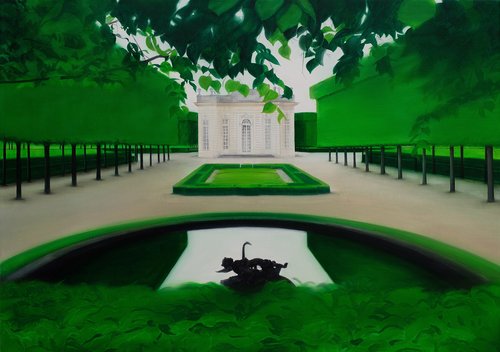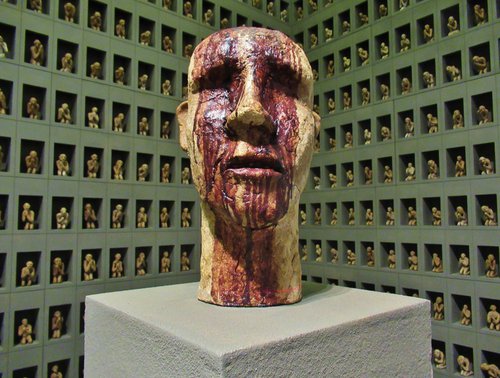Under the Same Sky: Egor Plotnikov in Compiègne

Egor Plotnikov. Sunrise. Normandy, 2025. Courtesy of Galerie Galerie de l’Est
In the quiet northern town of Compiègne, some eighty kilometres from Paris, Galerie de l’Est has invited Russian millennial painter Egor Plotnikov to spend a month looking upward. The result, ‘The Sky Above Our House’, is a cycle of sixteen landscapes painted entirely in situ, where Plotnikov’s virtuoso handling of paint turns clouds, horizons and changing weather into a meditation on time, memory and the enduring beauty of nature.
The Galerie de l’Est is a contemporary art gallery in Compiègne, a quiet town some eighty kilometers from Paris which is staging a solo show of paintings by Egor Plotnikov (b. 1980), called ‘The Sky Above Our House.’ It consists of a complete series of sixteen sky landscapes created by the artist during a one-month residency at the gallery. Dedicated to easel painting and landscape art, Plotnikov is a 21st century academic punk unapologetic of his métier even though some may see his style of painting as old-fashioned salon art. He shows us that true craftsmanship does not need to go out of style and that nature is never boring. His hometown Kirov, formerly called Vyatka, has produced numerous outstanding artists including the brothers Victor (1848–1926) and Apollinari Vasnetsov (1856–1933), Ivan Shishkin (1832–1898), Arkady Rylov (1870–1939) and Alexander Fistchev (1875–1968).
Plotnikov began his studies in earnest at the precocious age of eleven at an art school in Kirov, where he developed a strong attachment to landscape painting and the tradition of plein air work. He went on to study at the local art college named after his fellow Kirov native Arkady Rylov. Among his early inspirations, Plotnikov recalls two major exhibitions at the Fondation Louis Vuitton in Paris, devoted to the work of David Hockney (b. 1937) and Gerhard Richter (b. 1932). In his view, these artists “rehabilitated the landscape genre” and demonstrated that there is still much to be said within it.
Plotnikov’s collaboration with Galerie de l’Est dates back to 2018, and for the first time he decided to paint all the canvases for this show on site. He has dedicated the exhibition to his mentor, Pavel Nikonov (1930–2025), having learned of the artist’s death only the day before the opening. A leading proponent of the “austere style” in Soviet painting, Nikonov taught easel painting at the State Surikov Moscow Art Institute of the Russian Academy of Arts and trained many students who went on to become prominent artists. As Plotnikov explains, Nikonov’s studio was legendary and naturally evolved into a community that extended well beyond the institute: his students stayed in touch and remained close friends. Nikonov supported their first exhibitions, visited them regularly, and continued to paint actively until the very end of his life, at the age of ninety-five.
Time is an elusive presence in Plotnikov’s paintings. Natural landscapes can appear almost timeless, making it difficult to pinpoint when they were created. Yet attentive viewers will notice subtle signs of modernity: fields overgrown with young forest, the particular contours of cleared snow, and so on.
For many years, Plotnikov has been working on a series he calls Substractions, in which parts of the landscape are obscured by white, abstract geometric forms. For him, this device reflects the fragmentary nature of both personal and collective memory. The scene remains recognisable despite the missing sections. In this way, Plotnikov transforms the viewer from a passive observer into an active collaborator: as we look at his works, we are prompted to complete the image in our imagination, forge associations, and summon forgotten moments from the past.
Plotnikov is known for combining landscapes with sculptures. In the middle of the exhibition, there are several small human figures standing on an old wooden beam in the house. Made using the artist's signature papier-mâché technique, these characters are always monochrome, and mostly white. They seem to have just left the picture and turned into abstract, nominal humans. Years ago, Plotnikov experimented with smaller versions and later started installing larger ones, bringing his work closer to installations. The white figures help us focus more precisely on the landscapes and give the images a three-dimensional effect.
For Plotnikov, the sky is “a territory of plastic freedom, where every cloud is a dynamic, abstract sculpture that is constantly transforming,” he tells Art Focus Now at the opening of the solo show. He is fascinated by its visual and dimensional potential. “Clouds are material substances that live by their own rules”, that surpass not only geographic borders, but also the flux of time. Plotnikov acknowledges artists of the past who have inspired him the most, like Veronese (1528-1588), Nicolas Poussin (1594–1665), Caspar David Friedrich (1774–1840), Eugene Boudin (1824–1898), his compatriot Rylov and many more. There is a canvas in the corner suggestive of Kazimir Malevich (1879–1935). Plotnikov is not afraid of comparisons or references to other artists. To him, they represent a manifestation of artistic succession. He talks about how every artist sees landscape and nature through the lens of their profession. After numerous trips to France he identifies French skies with Boudin or Poussin. Plotnikov does not only “collect” different skies in his mind’s eye but inserts them into the spirit of our own time.
Plotnikov notes that in the stately portraits of the past, only the sky offered artists a free haven in which they could fully express themselves – confirming that it was, and remains, an open space for creation. For a long time, however, the sky was largely neglected, relegated to the distant third plane of the painting.
During his time in France, Plotnikov painted landscapes he had seen while travelling in Dauriya, the Far East, as well as the Arctic. He also painted a bird’s-eye view of the landscape around Kirov, as well as various locations in France, including Mont Saint-Michel, Compiègne, and the Côte d’Azur. There are times when he has waited a decade before returning to paint a certain place, an archival photograph prompting him to go back and paint it. Barely stopping, Plotnikov painted the entire series in just one month.
He approaches his work, ‘Where the Sky is Close to the Earth,’ which captures a summer view of the subarctic city of Novy Urengoy in Russia’s Yamal region. “The sky is very low over there,” Plotnikov says. “You get the feeling that it sticks to the sandy ground and low forest.” This painting evokes the Mont Saint-Michel in France, where the sky, ground, and water also “unite in one surface.” Next, we approach a winter landscape of the Côte d’Azur, where one can see that the winter there has brighter shades than the summer in Yamal.
‘Summer in the Steppe’ once again reveals the beauty of northern nature, depicting a view of the Hiloksky District in Russian Transbaikalia (or Dauriya), near the border with Mongolia. The rare warm days in these regions are suffused with restrained, refined colours. It is the North, rather than warmer parts of the world, that has continued to draw him back over the years.
Plotnikov loves the fine qualities of French paint and art supplies and during this residency he devoted himself entirely to an intense shade of blue. It is through his mastery of colour that Plotnikov successfully escapes monotony; his blue is so varied that it guides us through journeys of thousands of kilometres over hundreds of years.
Almost half of Plotnikov's landscapes are painted on round canvases, the artist points out that “the spherical vision is more natural for humans.” These pieces encourage viewers to slow down and take a moment for meditation and self-reflection. “The sky is above each one of us,” he says. His works radiate tranquility and balance, devoid of any exaggerated pathos. His sky is not a banner with white doves, but rather radiates genuine tranquility, calmness, and certainty. Plotnikov does not seem to be a naïve dreamer, but rather, he points to a “window of opportunity” and a path to inner calm. His sky unites and heals us all.
Egor Plotnikov: The Sky Above Our House
Compiègne, France
8 November – 20 December, 2025




















